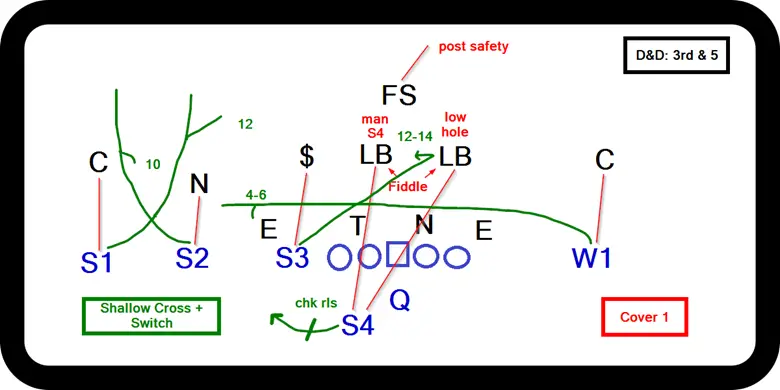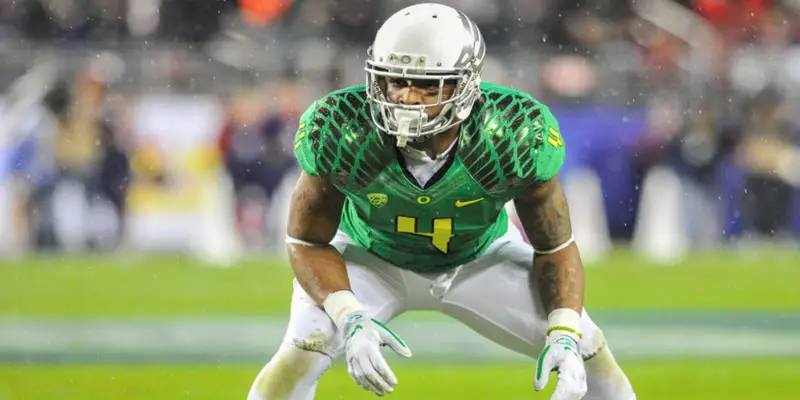“My friends, I wish to introduce you to Zach Pierson, a new analyst who employs a much different style than we have had from our analysis articles in the past. If you are willing to put in the time — you will learn an enormous amount, even if you do not understand all that is in the article. His writing is dense with information, and it’s his unique style that we welcome as we do the other analysts on the site. He is going to be analyzing every other game this fall, and we’ll learn more football!” – Charles Fischer
Welcome to the inaugural edition of X’s vs. O’s. In this series, we will analyze how Oregon utilizes different schemes and techniques to attack and defend the opposition. Today, we will discuss the Cover 1 defense, and see how it fared against a particular offensive play in the 2017 spring game.
A Cover 1 is a man coverage based defense that includes two different zone defenders. One zone defender (the “low hole”) covers the middle of the field in the short to intermediate area. The other zone defender (the “post safety”) covers the deep middle of the field. The defense is designed to funnel receiving threats inside, where the man defenders have help from the low hole linebacker and the post safety.
Let’s examine how this defense operates, using an example from the spring game. The offensive play we’ll use is a combination of the Shallow Cross and the Switch route concepts. We’ll review the job descriptions of five offensive skill positions: S1 through S4, and W1 (S for strong side and W for weak side), and then look at the job descriptions for the key defensive positions.

Offensive Job Descriptions
S1: Seam Read, Off a Switch Release
The wide receiver (WR) executes an inside release up the seam with an aiming point just outside the potential flat defender. His landmark is just outside the college hash marks. He runs the seam option if the middle of the field is closed (MOFC), and he breaks at 12 yards to run the skinny post option if the middle of the field is open (MOFO).
The WR reads the distribution of the safeties to determine the correct read. If a safety remains in the deep middle of the field, the WR may slightly widen his route to further stress the deep third defender (MOFC). If the safeties widen and vacate the middle of the field, the receiver will bend his route slightly inside to attack the vacated space (MOFO).
Either option is available versus a safety utilizing a flat foot read, but it is considerably more difficult to cross the safety’s face, since he will be playing with inside leverage.
S2: Wheel Route
The WR executes an outside release, with an aiming point slightly outside the painted numbers on the field (the “top of the numbers”). He continues up the sideline, unless the defender maintains a cushion of four to five yards. In that case, the WR slows down and eventually comes to a complete stop at a depth of 10 yards. He then shows the QB his hands, providing him with a nice stationary target. The WR should maintain four yards of separation from the sideline at all times to allow the QB sufficient space to place the ball.

S3: 12-14 Yard Snag Route
The WR takes an inside release and uses the pre-snap alignment of the opposite guard as his landmark. At the top of the route, he pivots back in the direction of the drag route. This route distribution effectively creates a “hi-lo” read for the QB.
This version of Shallow Cross provides the QB exactly the same picture as the Drive concept. The Drive concept consists of a 4-6 yard drag route and a 12-14 yard dig route, with both routes originating from the same side of the field.
S4: Check-and-Release Flare Route
In this example, the halfback (HB) is included in the protection scheme. If the HB’s blocking assignment does not blitz, he quickly gains width for five steps, then looks for the ball over his outside shoulder. His aiming point is the pre-snap alignment of S1. He needs to remember that gaining width is more important than depth as he widens to replace S1.
If the HB’s assignment does blitz, he will block him instead of running his assigned route. This “read and react” decision is why this type of route is referred to as a check-and-release route.
W1: 4-6 Yard Drag Route
Depending on the formation, the WR may need to reduce his split so the offense can maintain the proper timing and spacing of the route combination. As the route develops, the WR keys the flat defender for his read. If the flat defender widens sufficiently, the WR can settle in open space once he is past the pre-snap alignment of the opposite guard.
Here are a few coaching points for the drag runner:
- Look for the ball quickly in the event of a blitz.
- Execute a stair-step technique versus man coverage. This technique requires the WR to push up the field for one or two steps while “stepping on the defender’s toes”. The goal is to eliminate the cushion between himself and the defender before breaking flat across the field. This release should create separation at the top of the route, and allow the WR a better angle to the area where the ball is expected to be thrown.
- After settling in a soft spot versus a zone coverage, look for the QB to place the ball on the shoulder opposite the defender’s leverage.

Defensive Job Descriptions
Man Coverage Defenders
All the man defenders in this concept are operating with outside leverage. Their objective is to funnel the receiving threats inside, where they have help from the low hole linebacker and the post safety.
Fiddle Technique
In this assignment, both linebackers (LB) key the HB at the snap. If he releases in their direction, they will play him man-to-man while the other LB executes the low hole technique (see below). This two-on-one pseudo-bracket prevents the defense from being quickly out-leveraged by the offense.
Low Hole
This player executes a “Rat” technique. He should slowly and steadily gain depth, to a maximum of 10 yards, while looking to make contact with the first route to cross his face. This route will more than likely be a shallow or intermediate crossing route.
The low hole progression is shallow crossing route, to intermediate crossing route, to intermediate in-breaking route. He should be alert for screen passes and draw action, since his assignment places him in a good position to provide help against these strategies.
Post Safety
The post safety is responsible for the deep middle of the field. The progression is seam routes to post routes to dig routes. The safety must be as deep as the deepest offensive threat, so he can attack straight downhill at the appropriate angle to drive on the ball and contest passes.
If the middle of the field is threatened by multiple vertical routes, the post safety will apex (midpoint) the routes and break on the QB’s body language. He does this by reading the QB’s front shoulder. A high shoulder means a possible deep ball throw such as a fade or deep post, while a level shoulder means a more intermediate drive throw like a dig or skinny post is to be expected.
Example from the Spring Game: Why and How Did/Didn’t It Work?
The video above is an example of the Shallow Cross/Switch combination against the Cover 1 defense. On the chalkboard, this may not be the ideal play call for the offense in a 3rd-and-5 situation against this particular defense. The Cover 1 defense should be in a good position to defend this concept if the defenders execute their assignments properly.
The slot Defensive Back (DB) has outside leverage on S2, the Cornerback (CB) should have inside help on the vertical by S1 from the post safety, and the LB in the low hole correctly disrupts the drag route. This places considerable pressure on a receiver to “just win,” with little help from a schematic standpoint.
However, football is not played on a chalkboard. Players make instinctive decisions during the course of a football play. In this instance, the play ends on a happy note for the offense, due to a mental mistake by a defender.
The LB responsible for the HB in man coverage prematurely left his assignment to chase the QB, once he broke containment and escaped the pocket. This led to an easy completion, and ended with the HB scampering up the sideline.
Originally, the offense aligned in a 4X1 Quads Open formation before motioning the HB into the backfield. This type of alignment can force the defense to show their hand early, and allow the offense to determine if the defense is in a man or zone coverage before the snap.
The safety initially aligned over the HB when he was split out wide. This is a strong indication that the defense is in some kind of man coverage concept. In a zone concept, the CB would have stayed in his natural alignment, and therefore, the CB would have been positioned over the HB against the original offensive alignment.
In the video example, we see S2 runs more of an out-‘n’-up route rather than the traditional wheel route outlined in the job descriptions section. I believe this hurts the chance of success on this play; the wheel route is best run off the butt of S1.
This close proximity between the receivers on the release creates a natural rub or “pick” between the defenders. This can lead to more separation against man coverage, and can create a larger cushion against a zone defense.
Conclusion
The Switch concept was one of the most heavily utilized and successful concepts in the spring game, particularly off Power Read action in the play-action passing game. It is a versatile concept that can be surrounded with complementary routes to attack any defensive structure. I will be on the lookout for any additional route conversions off the switch release, and explore those in more detail if they appear on film during the season.
Thank you for joining me for the inaugural edition of X’s vs. O’s. I hope this post provided information that will further your enjoyment of the upcoming football season. I’m looking forward to watching, studying, and analyzing how the Ducks exploit their opponents throughout the season.
Zach Pierson
Birmingham, Alabama
Top Photo by Kevin Cline
Zach enjoys dissecting football gameplans and schemes from the confines of his home office on the outskirts of Birmingham, Alabama. His goal is to provide breakdowns that shed light on the intricacies of football, using simple, easy-to-understand language.

